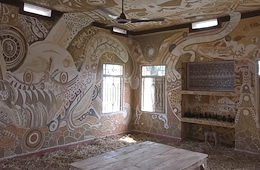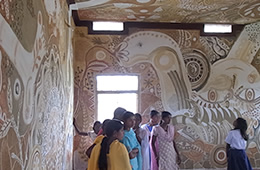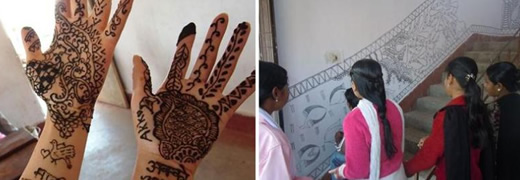The Japan Foundation, New Delhi:Contemporary Art and Social Development in Rural Villages in India: Attempts and Potential of Wall Art Festival
The Japan Foundation, New Delhi
With remarkable economic growth, India has been rapidly developing its urban areas. In fall 2010, the country hosted Commonwealth Games (an international sports event that takes place every four years in which the member countries and regions of the British Commonwealth participate) for the first time, and the international airport and subway network in the capital Delhi were improved in time for this event of national importance. While the urban areas benefit from such spectacular news, the rural areas have been left out of such economic growth. The development of infrastructure is still insufficient in many of these areas, and not a few children lack access to education.
 Sujata is a small village near Bodh Gaya, Bihar, one of the poorest in 28 states in India. Wall Art Festival was held in this small village from February 19 to 21, 2011, with participation of contemporary artists from Japan and India. It was the second occasion of the festival that started in 2010 when Japanese college students donated a school to the village with the money they earned from their part-time jobs. The school is called Niranjana Public Welfare School (NPWS) and operated by Indian youth in this village who had no access to education in their childhood. Today, the school has grown to be an important education site with more than 400 students from the surrounding area, thanks to cooperation from local residents. The larger the size of the school became as an essential facility of the village, however, the more financial and operational issues began to surface. The school staff and Japanese students who have been supporting the school brainstormed ideas of how to deal with these issues, and they came up with the concept of Wall Art Festival.
Sujata is a small village near Bodh Gaya, Bihar, one of the poorest in 28 states in India. Wall Art Festival was held in this small village from February 19 to 21, 2011, with participation of contemporary artists from Japan and India. It was the second occasion of the festival that started in 2010 when Japanese college students donated a school to the village with the money they earned from their part-time jobs. The school is called Niranjana Public Welfare School (NPWS) and operated by Indian youth in this village who had no access to education in their childhood. Today, the school has grown to be an important education site with more than 400 students from the surrounding area, thanks to cooperation from local residents. The larger the size of the school became as an essential facility of the village, however, the more financial and operational issues began to surface. The school staff and Japanese students who have been supporting the school brainstormed ideas of how to deal with these issues, and they came up with the concept of Wall Art Festival.
 Many unconventional ideas can be found in this unique attempt to invite contemporary artists in the international arena to a rural village in India that lacks basic infrastructures. The support group in Japan consisted mainly of college students, so it was difficult for them to provide the school with direct financial support. Instead, they thought about organizing a festival that could be an opportunity for the village to attract attentions from the world and to improve the environment. In India, a number of regions were known for their traditional wall paintings, and NPWS could offer many white walls, if not money, for painting. It was when they came up with the idea of a festival to paint on the walls of the school. If this festival could attract attentions from outside of the village, it could contribute to self-esteem and confidence of people in the village. In addition, the festival could bring visitors to this small village, as the author did.
Many unconventional ideas can be found in this unique attempt to invite contemporary artists in the international arena to a rural village in India that lacks basic infrastructures. The support group in Japan consisted mainly of college students, so it was difficult for them to provide the school with direct financial support. Instead, they thought about organizing a festival that could be an opportunity for the village to attract attentions from the world and to improve the environment. In India, a number of regions were known for their traditional wall paintings, and NPWS could offer many white walls, if not money, for painting. It was when they came up with the idea of a festival to paint on the walls of the school. If this festival could attract attentions from outside of the village, it could contribute to self-esteem and confidence of people in the village. In addition, the festival could bring visitors to this small village, as the author did.
What made this project more interesting was that it invited artists with global reputation to the festival. The artists showed positive interest and participated in the festival where they could collaborate with innocent children in the village surrounded by the beautiful scenery. One of these artists is Yusuke Asai, who participated in the festival two years in row. He showed a keen interest in traditional Indian wall paintings and planned field research in time for his visit to India this year. At the exhibition, he created a room by filling the entire walls and ceiling with paintings and covering the floor with straw. Working with children, he collected soils from various sites in the village and made pigments from the soils. He used the pigments to paint the walls so that he could draw the memory of the land on the wall.
 After the three-day exhibition was over, the Japan Foundation, New Delhi invited the artists for the Artist Talk. Delhi-based Indians gave us many questions and comments on this event. One of them said, "While many Indians today are turning their backs on their tradition in the wave of modernization, a Japanese artist discovers traditional Indian culture and takes it into his own expression to produce a new form of art. I'm touched." An art work presented by a Japanese artist based on his experience in Sujata stirred Indian's pride and love for their traditional culture.
After the three-day exhibition was over, the Japan Foundation, New Delhi invited the artists for the Artist Talk. Delhi-based Indians gave us many questions and comments on this event. One of them said, "While many Indians today are turning their backs on their tradition in the wave of modernization, a Japanese artist discovers traditional Indian culture and takes it into his own expression to produce a new form of art. I'm touched." An art work presented by a Japanese artist based on his experience in Sujata stirred Indian's pride and love for their traditional culture.
The third festival is already scheduled around the same period of February 2012. In addition, starting from April, artists and staffs involved in the festival will report on the project at various sites across Japan. If you are interested, please visit the official website of Wall Art Festival (http://wafes.net/index2.html).
Related Articles
Back Issues
- 2025.9.30 The 51st Japan Found…
- 2025.9.30 The Japan Foundation…
- 2025.9.30 Bringing the World C…
- 2025.9.30 The 51st (2024) Japa…
- 2025.9.30 Japan Foundation Pri…
- 2024.5.24 The 50th Japan Found…
- 2024.3. 4 Movie Theaters aroun…
- 2023.4.10 The 49th Japan Found…
- 2023.3.28 JF's Initiatives for…
- 2023.1.27 Living Together with…

